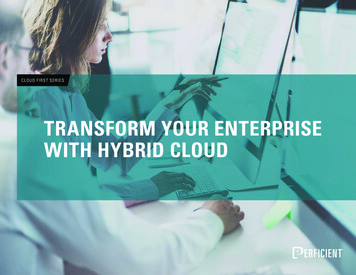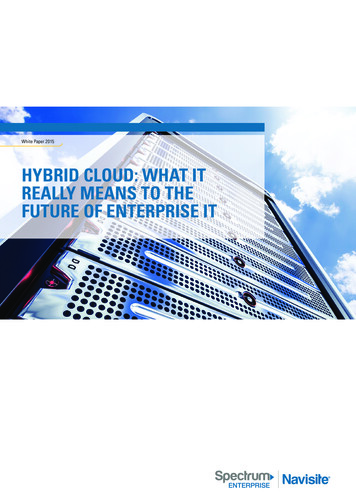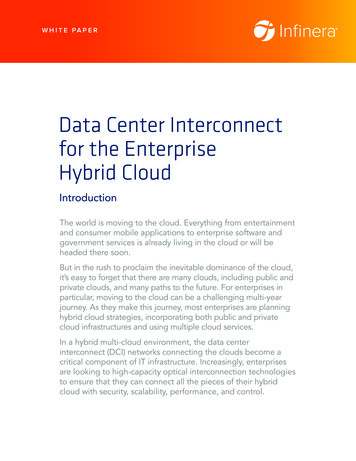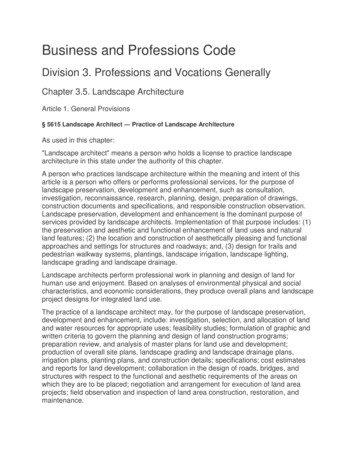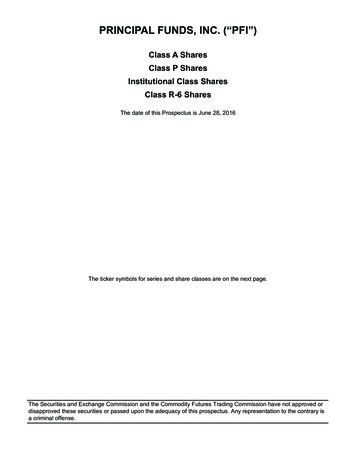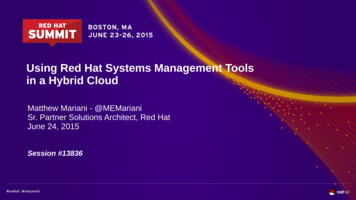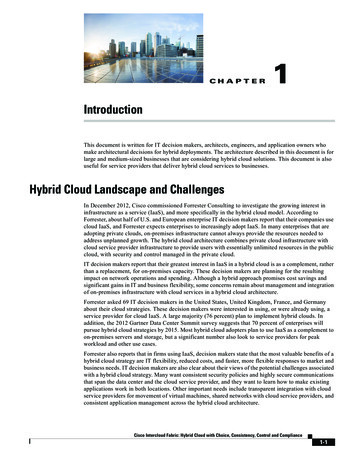
Transcription
CH A P T E R1IntroductionThis document is written for IT decision makers, architects, engineers, and application owners whomake architectural decisions for hybrid deployments. The architecture described in this document is forlarge and medium-sized businesses that are considering hybrid cloud solutions. This document is alsouseful for service providers that deliver hybrid cloud services to businesses.Hybrid Cloud Landscape and ChallengesIn December 2012, Cisco commissioned Forrester Consulting to investigate the growing interest ininfrastructure as a service (IaaS), and more specifically in the hybrid cloud model. According toForrester, about half of U.S. and European enterprise IT decision makers report that their companies usecloud IaaS, and Forrester expects enterprises to increasingly adopt IaaS. In many enterprises that areadopting private clouds, on-premises infrastructure cannot always provide the resources needed toaddress unplanned growth. The hybrid cloud architecture combines private cloud infrastructure withcloud service provider infrastructure to provide users with essentially unlimited resources in the publiccloud, with security and control managed in the private cloud.IT decision makers report that their greatest interest in IaaS in a hybrid cloud is as a complement, ratherthan a replacement, for on-premises capacity. These decision makers are planning for the resultingimpact on network operations and spending. Although a hybrid approach promises cost savings andsignificant gains in IT and business flexibility, some concerns remain about management and integrationof on-premises infrastructure with cloud services in a hybrid cloud architecture.Forrester asked 69 IT decision makers in the United States, United Kingdom, France, and Germanyabout their cloud strategies. These decision makers were interested in using, or were already using, aservice provider for cloud IaaS. A large majority (76 percent) plan to implement hybrid clouds. Inaddition, the 2012 Gartner Data Center Summit survey suggests that 70 percent of enterprises willpursue hybrid cloud strategies by 2015. Most hybrid cloud adopters plan to use IaaS as a complement toon-premises servers and storage, but a significant number also look to service providers for peakworkload and other use cases.Forrester also reports that in firms using IaaS, decision makers state that the most valuable benefits of ahybrid cloud strategy are IT flexibility, reduced costs, and faster, more flexible responses to market andbusiness needs. IT decision makers are also clear about their views of the potential challenges associatedwith a hybrid cloud strategy. Many want consistent security policies and highly secure communicationsthat span the data center and the cloud service provider, and they want to learn how to make existingapplications work in both locations. Other important needs include transparent integration with cloudservice providers for movement of virtual machines, shared networks with cloud service providers, andconsistent application management across the hybrid cloud architecture.Cisco Intercloud Fabric: Hybrid Cloud with Choice, Consistency, Control and Compliance1-1
Chapter 1IntroductionCisco Intercloud Fabric Overview and Value PropositionIT decision makers will seek solutions to these challenges using existing tools and skills, or they willexplore new offerings that make it easier to address the challenges of hybrid cloud strategies. Evolvingsolutions that address the most immediate hybrid cloud challenges include: Consistent policy enforcement and capabilities for firewalls, security, and application delivery Highly secure network connectivity for virtual machine migration A common view of workloads and resources across data centers and cloud service providers Support for heterogeneous hypervisor environments and infrastructure software Workload mobility and portabilityCisco Intercloud Fabric Overview and Value PropositionCisco Intercloud Fabric is a software solution that enables customers to manage and access theirworkloads across multiple public clouds in a heterogeneous environments, giving customers choice andflexibility to place their workloads where it benefits the most and according to a technical (capacity,security, etc.) or business (compliance, etc.) needs.With Cisco Intercloud Fabric, customers can choose what networks can be securely extended to thepublic cloud, and consistent network configuration and security policies can be enforced throughout thehybrid cloud. Intercloud Fabric mechanism to enforce security goes beyond the secure tunnel betweenprivate and public clouds, and extends the security all the way to the Virtual Machines (VMs) runningin the cloud, so the communication between these VMs in the cloud can be secured as well. Thismechanism is explained later in this document.Figure 1-1 illustrates the solution footprint for enterprise customers, where Cisco Intercloud Fabric forBusiness can be deployed in the private cloud in heterogeneous environments. This software solutiongives IT an admin portal that allows management of workloads, security policies, and network extensionto the cloud, and includes northbound API capabilities to allow integration with existing private cloudmanagement solutions. IT customers, including enterprise lines of businesses, can take advantage ofIntercloud Fabric for Business embedded self-service catalog to create new workloads in multipleclouds, and manage workload lifecycle and migration through its end-user portal.Figure 1-1Cisco Intercloud Fabric SolutionGUIAPIsCisco IntercloudFabric for BusinessHybridCisco IntercloudFabric for ProviderPublic295076Data Centeror PrivateCloud APIsCisco Intercloud Fabric for Provider is a multi-tenant software appliance that is installed and managedby the cloud providers that are part of the Intercloud Fabric ecosystem. This virtual appliance createsCloud API uniformity across different cloud providers and abstracts the complexity of supportingheterogeneous Cloud APIs. In the future Intercloud Fabric for Provider will help to build Ciscoinfrastructure-specific differentiation for all Cisco Powered Cloud Providers.Cisco Intercloud Fabric gives customers multiple choices of cloud providers, including the ecosystemof Cisco Powered Cloud Providers and the hyper scale public clouds such as Amazon EC2 and MicrosoftAzure. Cisco believes that business customers also want choices of hypervisors for their virtualizedCisco Intercloud Fabric: Hybrid Cloud with Choice, Consistency, Control and Compliance1-2
Chapter 1IntroductionCisco Intercloud Fabric Use Casesenvironment, so it is important for the solution that enables hybrid cloud to be hypervisor agnostic. Thescenario with multiple choices of hypervisors on premises and off premises can make workload mobilityand portability difficult, but Cisco Intercloud Fabric resolves this problem and makes this transparentfor customers, allowing workloads to be moved to multiple clouds and back to the enterprise.In summary, Cisco Intercloud Fabric aims to provide a more flexible response to business needs andaddresses the potential challenges of hybrid clouds, among other benefits that can be described asfollow: Workload security throughout the resulting hybrid clouds. Consistent operations and workload portability across clouds. Cisco Intercloud Fabric deliversunified hybrid cloud management for end users and IT administrators, enabling workload mobilityto and from service provider clouds for physical and virtual workloads. To protect critical business assets and meet compliance requirements, Cisco Intercloud Fabricprovides highly secure, scalable connectivity to extend private clouds to service provider clouds.Cisco Intercloud Fabric Use CasesCisco's industry research shows that the most common use cases for hybrid cloud designs aredevelopment and testing, capacity augmentation, and shadow (rogue) IT control. The Cisco IntercloudFabric roadmap adds support for disaster recovery.Development and TestingIn the development and testing use case, enterprise customers develop workloads in service providerclouds and bring the workload back to their private clouds after the workload is promoted to theproduction environment. To achieve the economic benefits of the cloud and support faster development,many application developers use service provider clouds for the development and testing environment.However, deployment of production applications in service provider clouds raises critical security andcompliance concerns for IT departments. IT decision makers want to provide flexibility to applicationdevelopers and enable them to use cloud service providers, but they require production workloads to bedeployed in private clouds with security and controls to meet compliance requirements such as PaymentCard Industry (PCI), Health Insurance Portability and Accountability Act (HIPAA), and Sarbanes-Oxleymandates. Cisco Intercloud Fabric provides this flexibility with its capability both to move workloadsinto service provider clouds and to bring workloads back into the customers' private clouds andon-premises infrastructure.Capacity AugmentationThe capacity augmentation use case addresses the need for temporary resources. For example, to meetseasonal demands, an enterprise can rely on the service provider cloud to provide temporary resources;when high-demand processing finishes, the resources are decommissioned. For example, during peakshopping seasons for retailers or tax season for financial services, there are planned and unplanneddemands for additional cloud resources for short and long durations. To achieve the economic benefitsof a hybrid cloud, customers can flexibly extend to service provider clouds to meet peak demands whilebenefiting from the security and control of the private cloud. The Cisco Intercloud Fabric solutiontransparently delivers required capacity while providing the security and control of a private cloud.Cisco Intercloud Fabric: Hybrid Cloud with Choice, Consistency, Control and Compliance1-3
Chapter 1IntroductionIntercloud Fabric Deployment ModelsShadow IT ControlMany enterprises prefer to deploy development workloads in the public cloud, primarily for convenienceand faster deployment. This approach can cause concern for IT administrators, who must control theflow of IT traffic and spending and help ensure the security of data and intellectual property. Withoutthe proper controls, data and intellectual property can escape this oversight. The Cisco Intercloud Fabricsolution helps control this shadow IT, discovering resources deployed in the public cloud outside ITcontrol (Appendix A, “Shadow IT and Cisco Cloud Consumption Professional Services”) and placingthese resources under Cisco Intercloud Fabric control.Intercloud Fabric Deployment ModelsCisco Intercloud Fabric addresses the cloud deployment requirements appropriate for two hybrid clouddeployment models: Enterprise Managed and Service Provider Managed.Enterprise ManagedIn the enterprise managed hybrid cloud deployment model, an enterprise manages its own cloudenvironments. Cisco Intercloud Fabric uses hybrid cloud scenarios, extending the private cloud into apublic cloud while granting administrative control over both the private and public clouds to theenterprise IT department.In this hybrid cloud scenario, an enterprise contracts with a service provider, and the service providerprovides some cloud resources (computing, storage, and network connectivity) for use by the enterprise.The enterprise, by using the Cisco Intercloud Fabric solution, then transparently and securely extendsits network into the public cloud, allowing those resources in the public cloud to be treated and handledjust as if they were in the on-premises private cloud. All security and policy requirements are appliedacross the entire hybrid cloud (Figure 1-2).Figure 1-2Enterprise Managed Hybrid CloudMicrosoftCisco IntercloudFabric for BusinessEnterprise DataCenter/Private CloudIntercloud Fabric for BusinessIntercloud Fabric for ProvidersCloud ProviderB295078Cloud ProviderACisco Intercloud Fabric: Hybrid Cloud with Choice, Consistency, Control and Compliance1-4
Chapter 1IntroductionGreenfield DeploymentService Provider ManagedIn the service provider managed hybrid cloud scenario, the service provider administers and controls allcloud resources. Customers of the service provider use those resources and deploy their workloads onthe service provider managed cloud, but the service provider retains administrative control over theentire cloud environment.This scenario allows customers to focus on bringing new applications and technology to the marketplacefaster, without having to focus on running the data center.This scenario still allows the creation and use of hybrid clouds. Cisco Intercloud Fabric providestransparent and highly secure connectivity between both private cloud environments (typically calledvirtual private clouds [VPCs]) and a variety of public clouds (Figure 1-3).Figure 1-3Service Provider Managed Hybrid CloudCloud ProviderEnterprise A - DataCenter/Private CloudShared orDedicatedCloudsEnterprise B - DataCenter/Private CloudIntercloud Fabric for BusinessIntercloud Fabric for Providers295079Enterprise B - DataCenter/Private CloudGreenfield DeploymentThe Cisco Intercloud Fabric solution can greatly benefit organizations that are in the early stages ofadopting the public cloud but have not yet taken that step. The Cisco Intercloud Fabric solution can moresecurely manage workload migration between private and public clouds and support cross-cloudpolicy consistency.Brownfield DeploymentOrganizations in which developers have already circumvented IT and deployed public cloud solutionscan use Cisco Cloud Consumption services (Appendix A, “Shadow IT and Cisco Cloud ConsumptionProfessional Services”) to identify public cloud use and restore cooperation between IT and developers.Such organizations can consider the following approach: Use Cisco Cloud Onboarding services to migrate workloads to a service provider that can meet theorganization's compliance requirements. These services provide the benefits of bulk purchasing,bringing all IT costs under a common authority, and meet availability and business-continuityrequirements.Cisco Intercloud Fabric: Hybrid Cloud with Choice, Consistency, Control and Compliance1-5
Chapter 1IntroductionBrownfield Deployment Return the workloads to IT management by deploying Cisco Intercloud Fabric and integrate thesolution with the organization's existing infrastructure and tools; this approach supports a simple,highly secure hybrid cloud integration plan. Continue using Cisco Cloud Consumption services to track public cloud use.Cisco Intercloud Fabric: Hybrid Cloud with Choice, Consistency, Control and Compliance1-6
In the enterprise managed hybrid cloud deployment model, an enterprise manages its own cloud environments. Cisco Intercloud Fabric uses hybrid cloud scenarios, extending the private cloud into a public cloud while granting administrative control over both the private and public clouds to the enterprise IT department.


